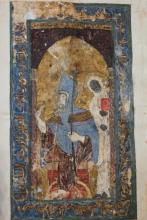
Abstract: This paper makes a case for the importance of the medieval Ethiopian diaspora to institutional Coptic identity in medieval Egypt. It centers on a twelfth-century manuscript produced and illuminated by Metropolitan Michael of Damietta, which includes a frontispiece that depicts Patriarch Mark III Ibn Zura with a dark-skinned attendant (BNF MS Copte 13, fol. 1r.). Often interpreted as an Ethiopian, the figure provides a convenient entrée into the topic of East African Christianity within Coptic self-presentation. Here, I consider the visual construction of ethnicity and status within the painting, and situate its production within intensified Coptic-Ethiopian exchange in the Fatimid and Ayyubid periods. The image also relates to biblical stories that cite Ethiopians to show the extent of the Christian world. Artifacts like MS Copte 13 offer an early glimpse of how Coptic religious leaders cited the Ethiopian diaspora in Egypt to enhance their political clout.
Speaker : Heather Badamo '03 is an associate professor in the History of Art and Architecture at the University of California, Santa Barbara. Her research investigates the arts of cross-cultural contact and exchange in the eastern Mediterranean, with a focus on Christian communities. Her first book, entitled George Between Empires: Image and Encounter in the Medieval East, comes out this December. Focusing on the period 1000–1450, it considers how rival Georges became central to different religious and political communities in Egypt, the Levant, Syria, Anatolia, and Georgia. Her next book, Art and Religion in the Age of Arabization: The Copts in the Medieval Islamic World, will explore how religious and lay elites employed visual culture to mediate communal memory and ensure Church survival during the eleventh through fourteenth centuries.


